December 21, 2013
by Carole Zangari -
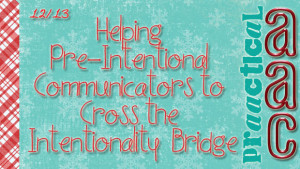
Earlier this month, we talked about the communication journey, from communication that is completely partner-inferred (pre-intentional) to communicating purposefully. The fastest route that we know of for helping clients become more purposeful communicators is a 3-step process. Select a Signal Believe it or not, we can get real intentional communication going with just a single motor act that will function as a signal. The Signal should be something the learner already does, such as moving an arm, tapping the tabletop, vocalizing in a certain way, or rocking. The Signal can also be the absence of movement. One beautiful little girl comes to mind as an example. She paced constantly, enough to wear down a track in the family room carpet – a neat little triangle from the TV to the sofa to her grandma’s recliner. When she wanted something she’d just stop pacing. (Sounds pretty straightforward but it took us... [Read More...]
Filed under: Strategy of the Month
Tagged With: beginning communicator, communication opportunity, pre-intentional
December 14, 2013
by Robin Parker -
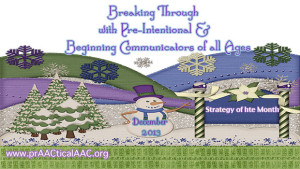
We are thinking a lot about emerging-intentional and beginning communicators. Even within these categories it seems there are sub-categories. We have a subset of learners who seem difficult to engage. They do not often respond to communication initiations by others. They can be content looking at small items or through self-stimulatory behaviors. These learners can get “communication” overlooked in class, in intervention, and at home because they can be quiet and subdued a lot of the time. They can be prompted through activities and events without difficulty but they often do not get to be communication initiators. And without a lot of practice initiating, it is hard to improve. You may hear or think these things about the learner: She does not like anything He is in his “own world” He does not care what he gets It seems like she can not hear She does not look at what... [Read More...]
Filed under: Strategy of the Month
December 7, 2013
by Carole Zangari -

Scene 1 Alex looks at the picture symbol choices placed in front of him and knocks them to the floor. Simone looks distressed while she waits for her lunch and whines as she watches her classmates eating. Jason smiles engagingly and rocks enthusiastically when his favorite aide enters the room. Kyra takes a picture from her PECS book and begins to chew on it. Scene 2 “He can’t even make choices. I’m not even sure what he wants.” “She really doesn’t communicate.” “He doesn’t mean anything by it. He does that all the time.” “She needs hand-over-hand prompting for everything.” Great kids, caring professionals. Ineffective communication. This month, we focus on ways to support children and adults at the earliest stages of communication. It isn’t easy trying to figure out how to provide effective SLP services to individuals who are not yet sending messages intentionally. Communicators at the pre-intentional level are... [Read More...]
Filed under: Strategy of the Month
Tagged With: beginning communicator, Communication Matrix, perlocutionary stage, preintentional communication
November 30, 2013
by Robin Parker -
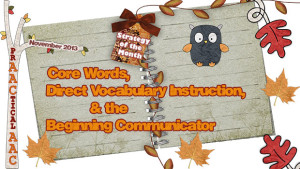
Direct vocabulary instruction is important for all level learners. The beginning communicator needs to learn core word vocabulary from USING the words and one of the best ways to learn how to USE core words, is to receive specific direct instruction with many opportunities for active participation. 6 Essential Philosophies & Strategies Vocabulary instruction involves a systematic TEACHING process. Add vocabulary or Words as an activity on the daily schedule and then have a mini-schedule for the specific vocabulary instruction activities for that day. Initially, apply an errorless learning paradigm. Then, gradually, add comprehension checks, but do not wait for ‘proof’ of comprehension before adding new words because we often notice that the beginning communicator will demonstrate comprehension during ‘unexpected opportunities- or when you are least expecting it. Once learners become familiar with some of the specific vocabulary activities, then have some choice making opportunities as to which ‘word activities’... [Read More...]
Filed under: Strategy of the Month
Tagged With: beginning communicator, vocabulary instruction
November 23, 2013
by Carole Zangari -
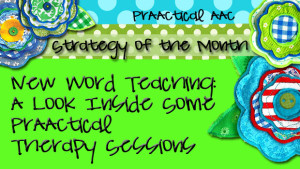
Since we’ve been talking about vocabulary instruction, we thought it might be fun to take a peek inside some therapy sessions where new words were being taught. In the examples below, we were teaching a core word and a Tier 2 vocabulary word over a few sessions. Here are some excerpts with their key intervention principles and practices. Target Words: do/did as an auxiliary (not main) verb Activities: Introduced a Visual Support (anchor chart): This explained the concept of ‘Helping Verbs,’ provided information on how they are used, listed them, and provided examples. These are effective tools for initial teaching, but are also invaluable for ongoing instruction. We use them extensively in language therapy, referring back to them often when we want to reinforce correct responses (look back at the visual together to further solidify the concept), help ‘fix’ incorrect responses (reteaching the pieces that didn’t stick), and facilitate self-correction... [Read More...]
Filed under: Strategy of the Month
Tagged With: anchor chart, semantics, visual support, vocabulary
November 9, 2013
by Robin Parker -
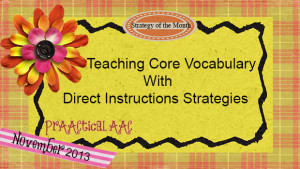
Vocabulary instruction involves a systematic TEACHING process. Core vocabulary words are harder to represent with pictures but still need to be taught with direct instruction. Many of the strategies and activities are part of general vocabulary teaching. Decide your core word vocabulary to teach and begin with strategies, steps, and fun activities. Teaching Strategies Teach in Meaningful Language Experiences– Create activities about the words but also about the communication behind the words. Develop activities that are meaningful to the learners. Provide Active Participation Opportunities- Develop many, many (many) opportunities for the learners to use the vocabulary as an expressive communication tool as well as for receptive language. Have the learner interact with the core word vocabulary rather than just listen to explanations. Give the vocabulary communicative power for the learner. Use Aided Language Input– Model AAC style. Use Focused Language Stimulation – Highlight new words and use them repetitively. We like... [Read More...]
Filed under: Strategy of the Month
November 2, 2013
by Carole Zangari -
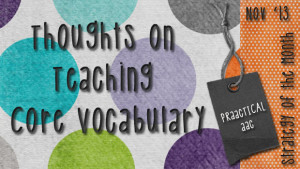
Teaching new words is something SLPs plan for in almost every service delivery setting. This month, we’ll focus on vocabulary instruction for core and extended vocabulary. Thoughts on Teaching Core Vocabulary In Advance Plan ahead. Make a rough plan of the core words you will teach and when you will introduce them to the AAC learner. Make sure there is plenty of variety, especially pronouns, verbs, prepositions, conjunctions, and determiners. Words for talking about time (e.g., now, later), asking questions (e.g., what, where), and negation (e.g., not) are important, too. Here’s a link to our post on A Year of Core and A Year of Core, Unity Style. Ensure that the AAC learner has access to communication aids with an adequate base of core vocabulary. What if the learner doesn’t have an SGD or AAC app that is core language based? If you can update that to something with good core... [Read More...]
Filed under: Strategy of the Month
Tagged With: core language, core vocabulary, intervention, semantics, vocabulary
October 26, 2013
by Robin Parker -
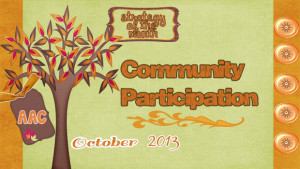
Community participation and communication for AAC users is an integral part of of developing, growing up, and having inclusive opportunities. We often relate community participation to quality of life indicators. Community participation for AAC users begins from the… beginning. Young children can order in restaurants, use picture menus, and have access to many inclusive events. As children grow into adolescents and adults, community participation involves post secondary options, employment, and community living. Perspectives from AAC Users Have communication displays and devices available at ALL times– You need access to a communication system(s) to participate in all situations. Remember to take AAC with you. The sooner the AAC user becomes responsible for taking or telling someone to take the device/displays with them the easier it becomes. For mobile technology systems, there are rugged cases that withstand wind, water, even medical waste (see Lauren Enders Pinterest boards for case and accessory options).... [Read More...]
Filed under: Strategy of the Month
October 19, 2013
by Carole Zangari -
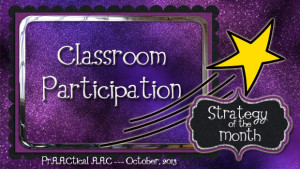
How can SLPs support students who use AAC and help them communicate more frequently in the classroom? Collaboration with the teacher is, of course, central to making this work. If you’re paired with an educator who knows, loves, and supports the AAC needs of her students, then you are in for a real treat. Collaborating with someone like that is fun and energizing. But what if your partner is new to AAC or one who doesn’t really know (or care to know) much about it? What if there is a bit of resistance to change or a passive-aggressive style? No match for a committed clinician! Ah. The ART of being an SLP. Take equal measures of creative problem-solving, wonderful pragmatics, and tenacity, and solutions will be found. In really sticky situations, we’ve seen colleagues make breakthroughs on the strength of brownies and iced coffee. You know how to make this... [Read More...]
Filed under: Strategy of the Month
Tagged With: classroom, education, participation
October 12, 2013
by Robin Parker -
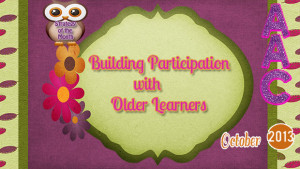
We love active participation for communication and language learning. Actually, we love active participation in all areas of life for us, for our students, for everyone. When Carole introduced the Building Participation Strategy of the Month, she discussed the role of the Participation Model (Beukelman & Mirenda, 1988; 2013). The Participation Model is a framework for understanding the barriers to participation and then from a prAACtical intervention standpoint developing strategies and activities to increase active participation in a variety of (ALL) aspects of life. For the 2012 AAC Awareness Month, we discussed barriers to participation. This year’s focus is on activities and strategies for getting past the barriers to building age appropriate authentic active participation for ALL learners. We have learned that when older learners with significant communication challenges are provided with age appropriate activities and supports, they can be engaged and motivated to participate and can often surprise us with... [Read More...]
Filed under: Strategy of the Month
Tagged With: activities, building participation, older learner, partner strategies, resources, teaching strategies









